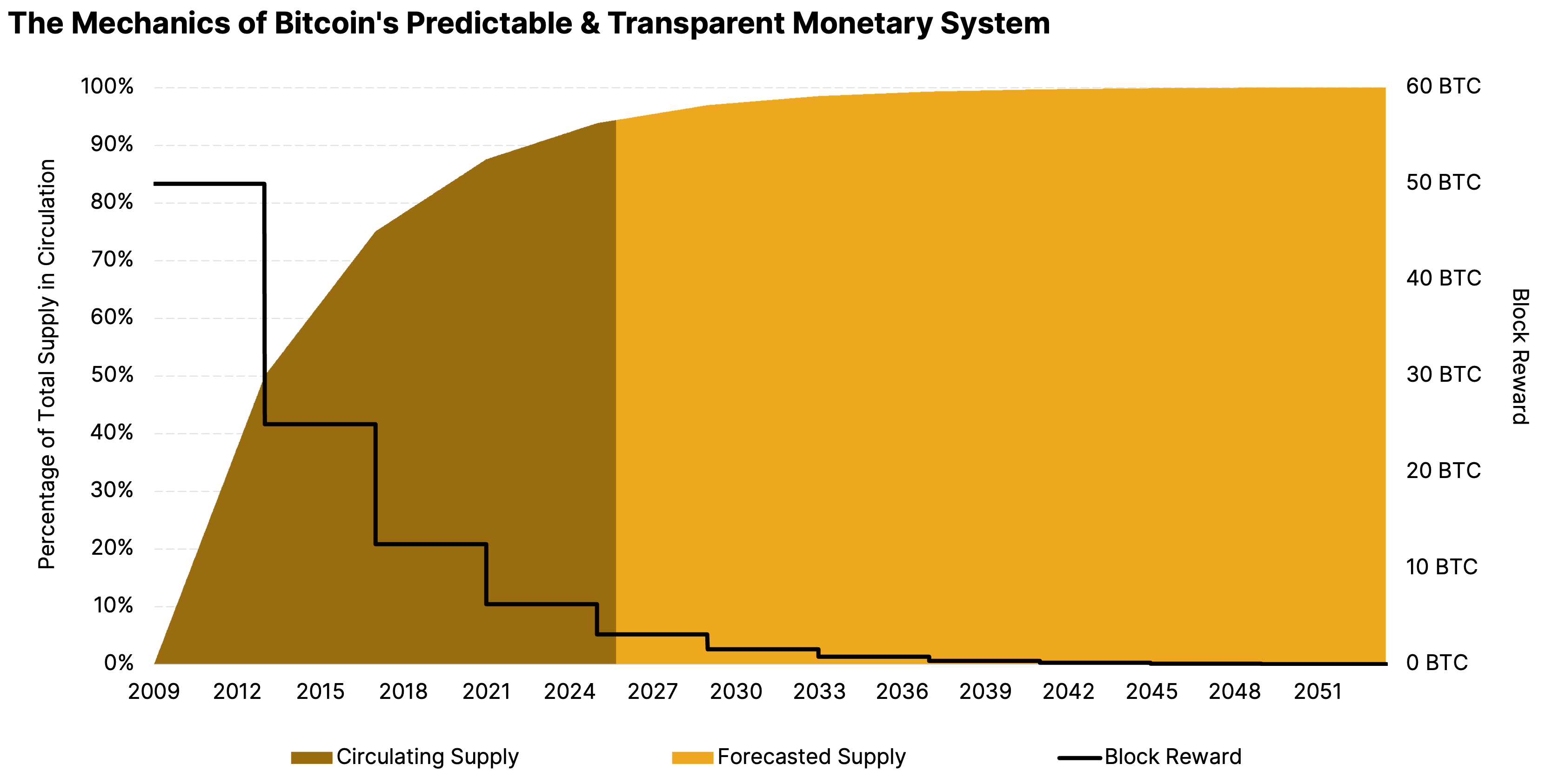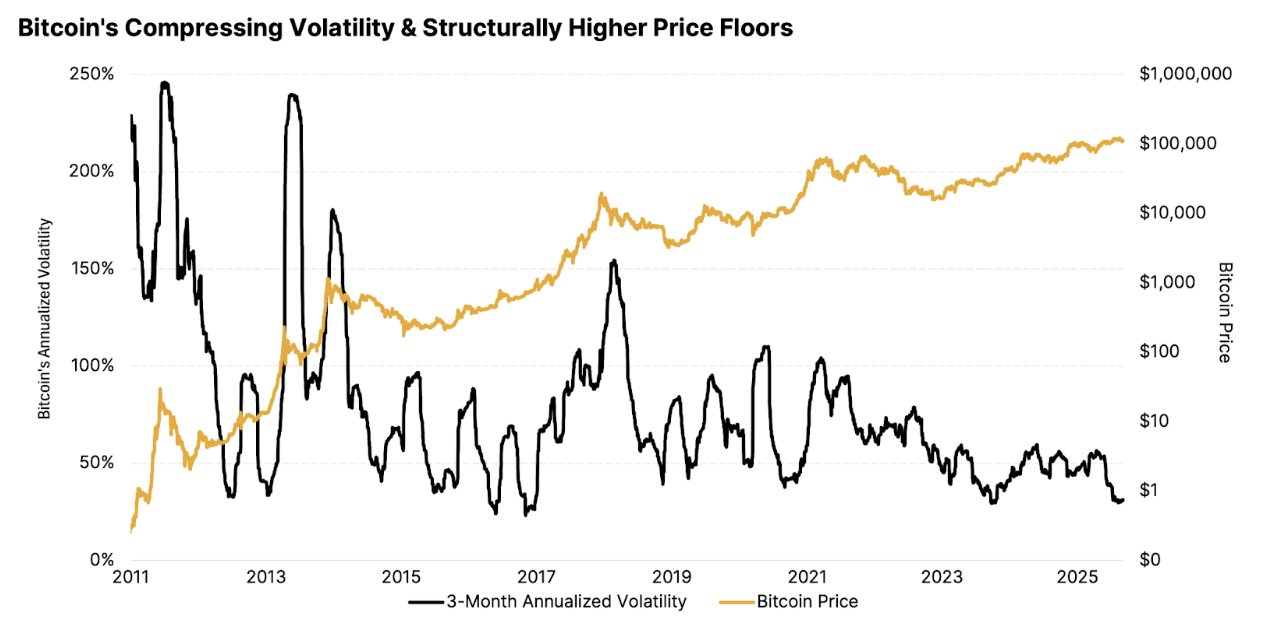Bitcoin’s rise has reshaped finance. Once dismissed as speculative, it’s now becoming a global macro asset. Backed by spot ETFs and regulatory clarity in 2025, Bitcoin surged past $126,000. With corporations, governments, and institutions piling in, the question is: can it truly rival gold in traditional portfolios?
Created in 2009 by Satoshi Nakamoto, Bitcoin emerged from the global financial crisis as a peer-to-peer monetary system, immune to central bank interference.
Its defining feature is scarcity. The supply is permanently capped at 21 million coins, with more than 95% already mined. New issuance follows a fixed schedule: every four years, the “halving” cuts the block reward in half, steadily reducing the flow of new Bitcoin. Today, Bitcoin’s inflation rate is already lower than gold’s, a sharp contrast to fiat currencies, which can be expanded at political discretion. For investors, this makes Bitcoin a structural hedge against debasement.
Figure 1 – Bitcoin’s Circulating Supply vs. Block Reward

Source: 21Shares, Glassnode. Data as of September 5, 2025
But Bitcoin goes beyond gold. It is easier to store, transfer, divide, and verify, offering a level of transparency unmatched in financial history. It is globally accessible, infinitely portable, and resistant to counterfeiting. These traits reimagine gold’s role for the digital age, positioning Bitcoin as the programmable store of value, a commodity fit for a digital-first financial system.
The Investment Case: Institutions are catching on Supply Squeeze
Bitcoin’s fundamentals remain unchanged, what’s shifted is who’s embracing them. On the corporate side, adoption has surged. Strategy, the largest public holder, now owns over 630,000 BTC, more than 3% of supply. Corporations overall added 400,000+ BTC to balance sheets this year, setting a new institutional benchmark.
Governments are entering too. The US Strategic Bitcoin Reserve launched in March with 200,000 BTC, making it the largest sovereign holder. States like New Hampshire and Arizona passed reserve laws, while countries from El Salvador to Pakistan are crafting national Bitcoin strategies. These moves underscore Bitcoin’s growing recognition as a sovereign-grade asset.
This demand is colliding with engineered scarcity. In 2025, just 112,000 new BTC were mined, yet over 628,000 BTC were absorbed by corporates, ETFs, and governments, more than six times the new supply. These aren’t short-term trades, they’re structural, long-term holdings.
Figure 2 – Bitcoin’s Newly Issued Supply in 2025 vs. Bitcoin Absorbed by ETFs, Corporations and Governments

Source: 21Shares, Glassnode. Data as of September 5, 2025
Meanwhile, nearly half of all Bitcoin hasn’t moved in over three years, and exchange balances are at seven-year lows, amplifying the squeeze.
Macro conditions add fuel: U.S. tariffs are at 18.6%, the highest since the 1930s. Debt has surged past $37 trillion, with annual interest exceeding $1 trillion. Treasuries have diverged from gold, reflecting fading trust in sovereign debt. Investors are shifting to politically neutral, hard assets. Gold is up 55% YTD with $46B in ETF inflows.
Yet Bitcoin is up nearly 25%. Bitcoin ETF inflows top $19B, and adoption exceeds 15–20% in high-inflation economies like Turkey and Argentina, affirming its role as a global hedge.
Bitcoin is maturing into a dual-natured macro asset. It rallies in risk-on markets and hedges in risk-off periods. As volatility compresses and adoption widens, it’s becoming a global store of value with one of the most asymmetric opportunities in modern finance.
Figure 3 – Bitcoin’s Annualized Volatility vs. Price

Source: 21Shares, Glassnode. Data as of September 5, 2025
Correlation and Portfolio Analysis: Bitcoin’s Jekyll & Hyde Nature
For mainstream portfolios, the real question isn’t whether Bitcoin replaces gold but whether it complements it. Correlation analysis offers the clearest lens into that role.
Over the last three years, Bitcoin, Ethereum, and the broader crypto market have all shown consistently low correlations with traditional asset classes, averaging just 30–35%. By contrast, equities, bonds, and real estate often cluster above 50%, limiting diversification.
Figure 4 – Correlation of Returns Across Asset Classes

Source: 21Shares, Bloomberg, Yahoo Finance. Correlation calculated on a 10D rolling return window from September 1, 2022 – August 31, 2025. Representative assets: U.S. Equity (SPY), U.S. Tech Equity (ARKK), Emerging Equity (EEM), Real Estate (VNQ), U.S. Treasuries (TLT), Gold (GLD), Bitcoin (BTC), Ethereum (ETH), Broader Crypto Market (Total Crypto Market excl. BTC & ETH)
Bitcoin’s average correlation with U.S. equities is just 22%, and only 11% with gold. Structurally, it shares gold’s store-of-value traits yet its behavior, as previously mentioned shifts with the macro regime. This adaptive profile makes Bitcoin unique: neither fully risk-on nor risk-off, but a dynamic blend of both.
For investors, this duality is not a flaw but a feature. It means Bitcoin brings genuinely independent return streams into portfolios, diversifying risk rather than amplifying it. As crypto matures, correlations within the asset class itself are also beginning to decouple, Ethereum and the broader market are showing differentiated narratives that could evolve into distinct cycles.
To assess Bitcoin’s role in a real-world context, we tested its impact within a diversified multi-asset portfolio. We used a model allocation that better reflects the complexity of modern investor strategies, combining equities (50%), fixed income & credit (30%), and alternatives (20%), incorporating gold (5%), real estate (5%), and private equity (10%).
From this base, we introduced a 5% Bitcoin allocation, funded by trimming U.S. equities (–2%), gold (–2%), and real estate (–1%). This reflects Bitcoin’s blended profile as both a growth asset (justifying the equity reallocation) and a hard-asset hedge (justifying the alternatives sleeve reallocation).
- Stronger Risk-Adjusted Returns: Cumulative returns rose to 65.34%, over 20% higher than the benchmark portfolio. Sharpe ratios improved materially, highlighting that Bitcoin boosted portfolio efficiency rather than simply adding risk.
- Manageable Volatility: Despite Bitcoin’s reputation for sharp swings, annualized portfolio volatility remained between 10.74% and 11.76%, only slightly above the benchmark’s 10.34%. This shows Bitcoin’s volatility doesn’t scale linearly at the portfolio level.
- Well-Contained Downside: Maximum drawdowns stayed clustered around –15%, nearly identical to the benchmark. Relative drawdowns peaked at just –0.52%, underscoring that even with higher exposure, Bitcoin did not materially worsen downside risk.
Figure 5 – Simple Growth Portfolio with a 5% BTC Allocation Across Different Rebalancing Strategies

Source: 21Shares, Bloomberg, Yahoo Finance. Data from September 1, 2022 – August 31, 2025. Model Portfolio: Equities (50%): 35% U.S. Equity – SPDR S&P 500 ETF Trust (SPY), 15% Non-U.S. Equity – Vanguard Total International Stock ETF (VXUS), Fixed Income & Credit (30%): 25% Public Fixed Income – iShares Core U.S. Aggregate Bond ETF (AGG), 5% Private Credit – VanEck BDC Income ETF (BIZD), Alternatives (20%): 10% Private Equity – Invesco Global Listed Private Equity ETF (PSP), 5% Real Estate – Vanguard Real Estate ETF (VNQ), 5% Gold – SPDR Gold Shares Trust (GLD)
Bitcoin is proving itself as a portfolio-grade asset. A thoughtfully sized allocation can materially improve returns and efficiency without meaningfully increasing risk. Its Jekyll & Hyde nature, growth in risk-on regimes, defense in times of stress, makes it a powerful complement to traditional safe havens like gold, rather than a replacement, at least for now.
Bitcoin’s Role in the Next Era of Portfolios
From its beginnings as a niche experiment to its emergence as a macro asset, Bitcoin has matured into something fundamentally different. Correlation and portfolio analysis confirm that Bitcoin adds diversification benefits at scale, strengthening performance while maintaining resilience. Gold will remain a cornerstone of safe-haven allocations, but Bitcoin’s evolution means it now deserves a seat at the same table. For mainstream investors, the question is no longer if Bitcoin belongs in portfolios, but how much exposure is appropriate in the years ahead.

